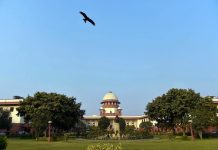This article is written by Ansruta Debnath, a student currently pursuing the BA LLB degree from National Law University Odisha. This article explores the implications the 2020 Shaheen Bagh judgment has on the right to protest in India.
Table of Contents
Introduction
The right to protest is a fundamental right enshrined in the Indian Constitution. But the Shaheen Bagh judgment has substantially reduced the right given by it. It thus becomes important to analyze the judgment in detail and understand why the principles used in it, although given in good faith, form a dangerous precedent that can be easily used by authorities to arbitrarily clamp down on dissent.
Facts of the case
The Shahen Bagh protest was an iconic protest launched in December of 2019 by women, children and senior citizens against the Citizenship (Amendment) Act, 2019 (hereinafter, referred to as CAA). The protesters were mainly Muslim. Their primary point of contention was the fact that through the CAA, persecuted minorities from Afghanistan, Pakistan and Bangladesh would be given citizenship in India but Muslim persecuted minorities would not. This unfair nature of differentiating on the basis of religion goes completely against the basic tenet of secularity embodied in the Indian Constitution. Coupled with the hotly debated NRC, the CAA has been seen as a method of disenfranchising Indian Muslims. The protest was in the form of a mass-sit in the Kalindi Kunj-Shaheen Bagh present in the north-eastern part of Delhi and resulted in the closure of the entire stretch of road.
Because of the block-in, numerous petitions were filed demanding a clearance of the road. The petition on which the Court decided to give its judgment was Amit Sahni v. Commissioner of Police and Ors. (2020). The writ petition was originally filed in the Delhi High Court where the petitioner contended that blocking a public road was against the Indian Constitutional regime and that the Court should take measures to clear the said road. The judges in the Delhi Court, however, decided to not adjudicate on the issue and left it to the Delhi Police and other authorities to decide. The Delhi Court also cautioned authorities saying that, while taking a decision, they must keep the greater public interest in mind. Importance was also given to the maintenance of law and order. The Court felt that an appropriate order could not be given until the ground reality was assessed and the best person to do that was the Delhi Police.
The situation, however, remained the same and subsequently, a special leave petition was filed and the entire thing went on appeal to the Supreme Court of India. Two other writ petitions were “dismissed as withdrawn”. Before the judgment was given, the Court had directed for mediation to take place between the petitioners and the protestors. However, no one could reach any consensus.
Judgment
The Supreme Court gave its judgment in October of 2020 despite the fact that the protest could not continue because of the COVID 19 pandemic and subsequent lockdown. The Apex Court felt that there was a further need to provide a written judgment on this issue.
Right to protest : a fundamental right with restrictions
The Court held that even when the right to protest was a fundamental right granted by the Indian Constitution, it had to be subjected to reasonable restrictions related to public order, sovereignty and integrity of India and “regulation by the concerned police authorities in this regard”.
While recognizing the right to freedom of speech and expression under Article 19(1)(a) and the right to assemble peacefully without arms under Article 19(1)(b), the Court held that public spaces could not be occupied, especially indefinitely. While “democracy and dissent went hand-in-hand”, dissent could take place only in designated places. Shaheen Bagh could not be a designated place because it was a road used frequently by commuters and the sit-in was causing a lot of inconvenience to said commuters.
Furthermore, the Court refused to accept the plea that an indeterminable number of people could assemble whenever they chose to protest.
Balance between right to travel and right to protest
Although not explicitly mentioned in the judgment, an implied balance must be struck between various rights. In the case in contention, the right to travel of the commuters of Shaheen Bagh was being affected. Right to travel freely across the territory of India has been guaranteed by Article 19(1)(d) of the Indian Constitution. One right cannot be given more importance than the other. What is needed is to ensure that policies and rules being made conform to the greater public good.
Dismissal of review petition
The Supreme Court in 2021 dismissed a review petition which challenged its Shaheen Bagh judgment. It reiterated its stand that while spontaneous protests could be allowed, prolonged protests would under no circumstance be allowed in public spaces. It is interesting to note that the three-judge bench that examined the review petition was the same bench that gave the verdict in the original judgment.
Implications of Shaheen Bagh judgment
Increased restrictions
For starters, one very important aspect of the judgment is that the Court added on to the reasonable restrictions given in the Constitution. Article 19 allows reasonable restrictions related to “sovereignty and integrity of India, the security of the State, friendly relations with foreign States, public order, decency or morality or in relation to contempt of court, defamation or incitement to an offence”.
However, the Apex Court went to note that fundamental rights were subject to “regulation by the concerned police authorities in this regard”. This contention substantially widens the ambit of restrictions and can prove to be dangerous to the right to dissent. Our Constitution framers had included the restrictions with the hope that they could not be widened by executive and legislature and the same would be ensured by our judiciary. However, here the judiciary ends up compressing the rights available on the grounds of “inconvenience caused to the commuters”.
The Supreme Court, in Anuradha Bhasin v. Union Of India (2020), had made a distinction between “law and order” and “public order” and said there was a higher threshold for activation of restrictions under public order. Mere inconvenience cannot be a reasonable threat to public order. However, the Court in this judgment failed to explain why they considered said inconvenience a proper ground for reasonable restrictions to come into play.
Meaning of public protest
The Court held that protests could not take place in public places. But a public protest by its definition implies a protest in places that are public and available to all. When it is in a public location, it will create inconvenience to someone else who genuinely wished to utilise that space for a different reason. If the Supreme Court’s decision is to be followed, then it automatically implies that the ability to protest anywhere will be reduced considerably.
Did protestors cause inconvenience
Another important point to note is the inconvenience caused to the commuters was aggravated because they were unable to access any other alternate routes, as they too were apparently blocked in by the protestors. But later, reports emerged which said that the alternate routes had been barricaded by the police itself, not the protestors. Thus, it is strange that the Court failed to include this bit of information in its judgment. This entire scenario implies that if the police can somehow prove an inconvenience for the commuters, then such inconvenience will be understood to be a threat to public order and would not have the Constitutional backing of the right to protest.
Vague terms
The judgment asks for protests to take place in designated areas. Yet, the Court does not elaborate on what a designated area can be. This non-specification might be arbitrarily used by authorities to stifle dissent.
This vagueness is also found in other terms used in the judgment. The Court has said that such protests cannot go on indefinitely. However, what exactly will be considered an indefinite period was not elaborated upon, which yet again opens up avenues for arbitrary state action.
Lack of binding value
This case has been said to not have a ratio decidendi at all. This is because the Court gave a decision based on a protest that had already been wrapped up. It has been contended that since there was no case, there cannot be any ratio that automatically implies that the judgment should not have any binding value. With regards to whether there is persuasive value, the entire Shaheen Bagh judgment can be said to have set a dangerous precedent with regards to the right to protest given to the citizens of India.
Other judgments on the right to protest
- In Beenu Rawat v. Union of India (2013) the Supreme Court held that there must be a balance between rights and duties. While everyone has the right to protest against arbitrary state action, protesting against police action (or inaction) becomes especially dangerous because there is a higher chance of fundamental rights being violated. At the same time, people could not paralyse state machinery in the name of protest. People had a right to protest and a duty to not break the law. Police had the duty to maintain law and order. In this sense, there must be a balance as “rights without duties tend to degenerate into a license for misuse of rights”.
- In another case, Anita Thakur v. the State of J&K (2016), the Apex Court held that there was a fundamental right to protest using freedom of speech and expression and form peaceful assemblies. Only when said assemblies became unlawful could they be dispersed using force. However, the Court cautioned that force had to be reasonable and not excessive in nature.
- The Shaheen Bagh judgment used Mazdoor Kisan Shakti Sangathan v. Union of India & Anr. (2018) Here the main point of contention was whether disturbances caused to residents were a larger public interest for which the right to protest in that area could be restricted. There had to be a balance between rights accorded to all. The Court in this scenario held that the protest in contention was causing serious harassment to the residents. At the same time, the site of protest which was Jantar Mantar, was a common place to hold protests and was also recognized by the authorities. So the Court directed the authorities to formulate proper and requisite guidelines for regulating protests in and around the area.
- In Himat Lal K. Shah v. Commissioner of Police, Ahmedabad & Anr. (1972), a challenge was made to the rules framed by the Commissioner of Police, Ahmedabad, by the powers conferred under Section 33(1)(o) of the Bombay Police Act, 1951. One of these rules required that prior authorization be obtained before holding public meetings. The Supreme Court ruled that the state may only enact laws in support of each citizen’s right to assemble and can only impose reasonable limits in the interests of public order. In determining whether these rules violated Article 19(1)(b) of the Indian Constitution, it was determined that, while the State cannot impose unreasonable restrictions, the right to hold meetings on public streets was subject to the control of the appropriate authority regarding the time and place of the meeting, as well as considerations of public order.
However, because the rule requiring prior permission from the concerned authority did not include any guidance as to when such permission to hold a public meeting could be refused, it was determined that the rule conferred arbitrary powers and gave the concerned authority unguided discretion, and this was thus held to be against Article 19(1)(b) of the Constitution. This case was also mentioned in the judgment of Shaheen Bagh.
Conclusion
From our above-mentioned discussion, it is clear that the judgment needs to be given much more clarity. As was aptly put, “Constitutional questions require dissection with a sharp surgical knife; what the Supreme Court used in the Shaheen Bagh case instead was a hacksaw”. It is very important that the judgment given is promptly revised to prevent unpredictable behaviour by authorities in case of protests.
References
- Amit Sahni vs Commissioner Of Police on 7 October, 2020
- Supreme Court refuses to review order on Shaheen Bagh protests
- Public places cannot be occupied indefinitely: Supreme Court
- Why Shaheen Bagh Verdict By Supreme Court Threatens Rights In Favour Of Restrictions | OPINION
- Supreme Court’s Shaheen Bagh judgment is well-meaning judicial anguish, not binding law
Students of Lawsikho courses regularly produce writing assignments and work on practical exercises as a part of their coursework and develop themselves in real-life practical skills.
LawSikho has created a telegram group for exchanging legal knowledge, referrals, and various opportunities. You can click on this link and join:
https://t.me/joinchat/L9vr7LmS9pJjYTQ9
Follow us on Instagram and subscribe to our YouTube channel for more amazing legal content.
 Serato DJ Crack 2025Serato DJ PRO Crack
Serato DJ Crack 2025Serato DJ PRO Crack











 Allow notifications
Allow notifications



